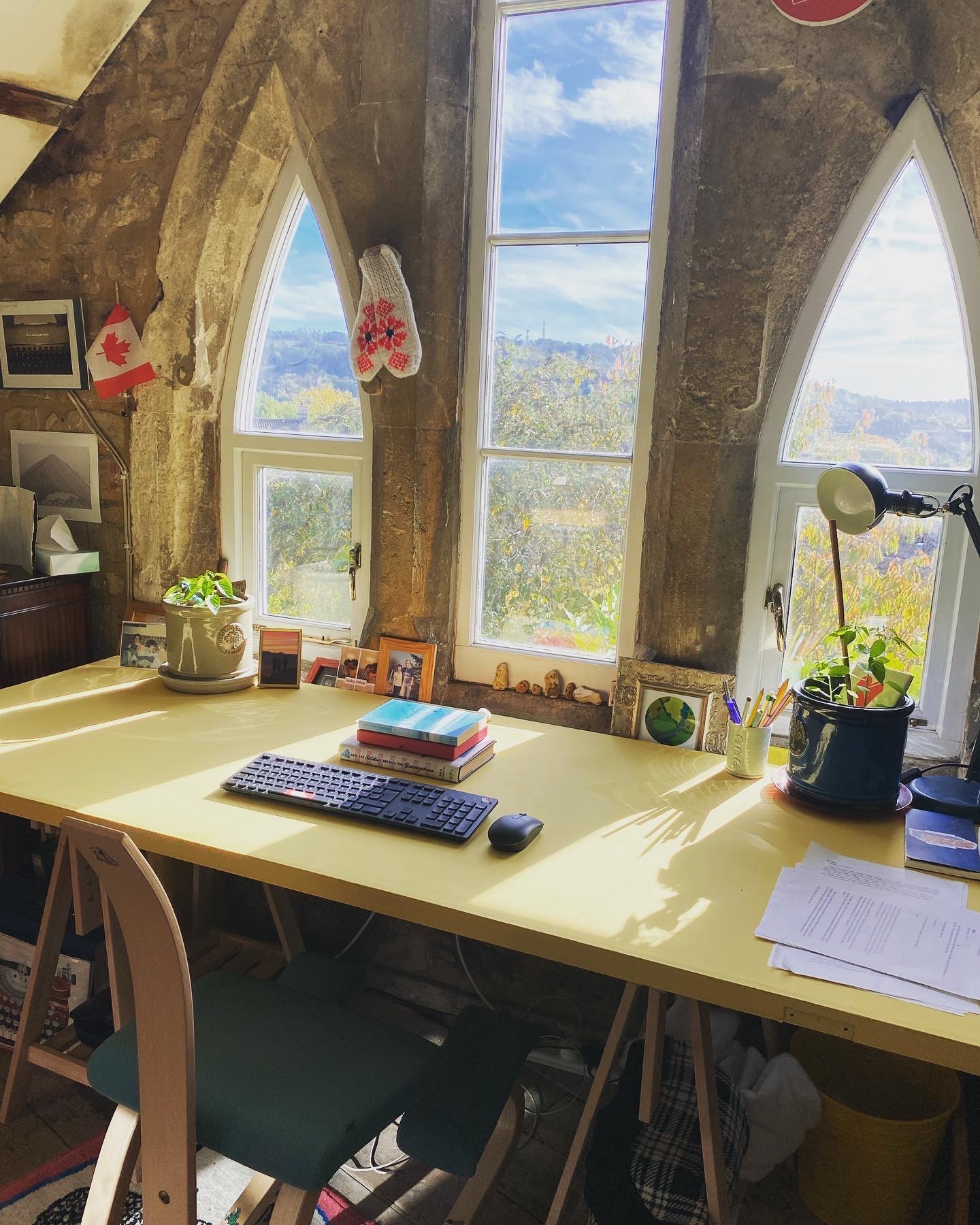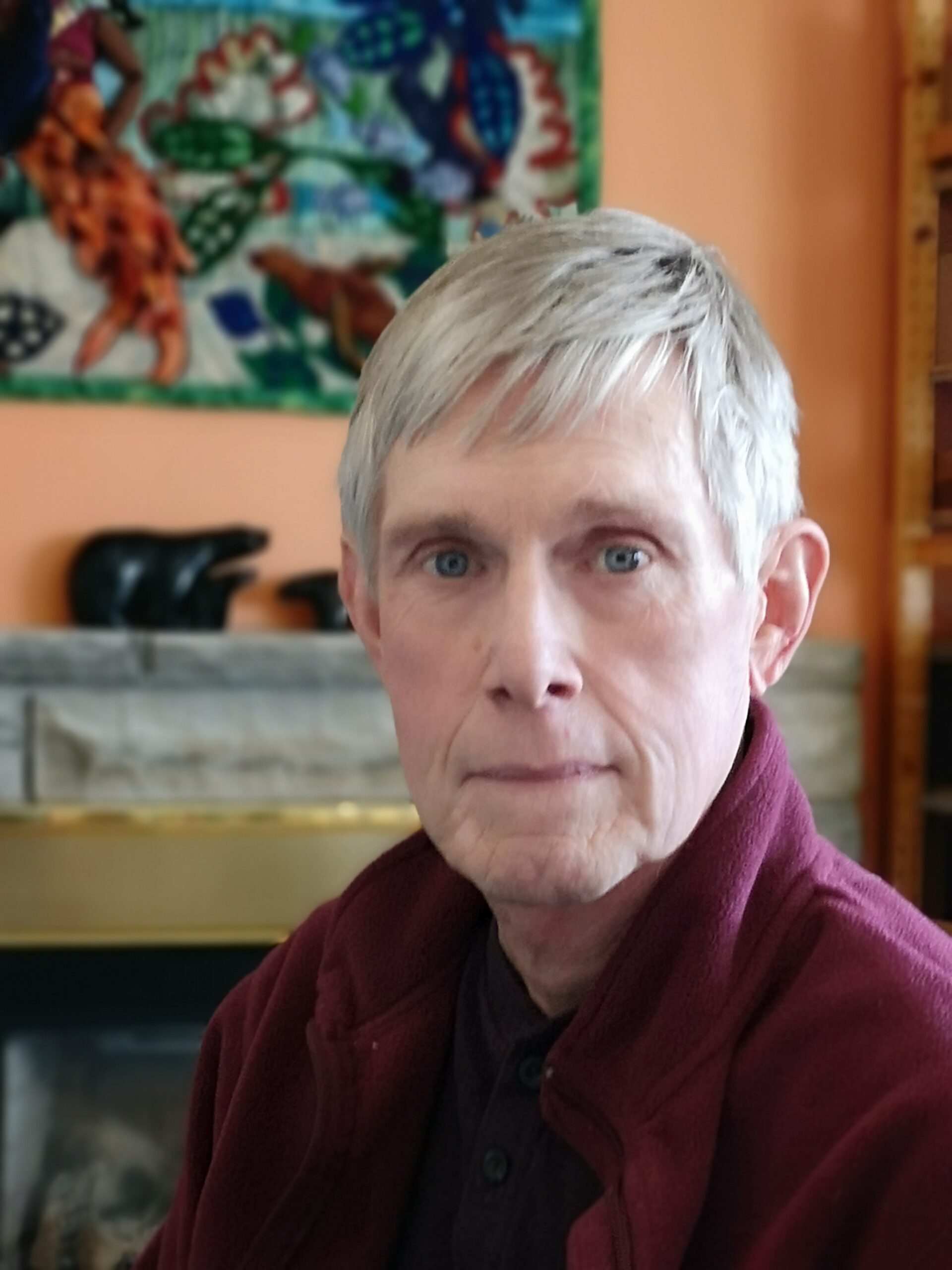Uncategorised
Emma Hooper’s Writing Space
Some people don’t like a window where they work; they point their desks away from them. If I don’t have a window it’s kind of like not being able to breath. I point myself straight at mine and keep tabs on the birds.
Sometimes I see groups of young teenagers too. We’re on some kind of trekking route and they usually seem confused, wandering lost on overly-ambitious orienteering missions. Me too, I think, me too.
My desk was a door once. I noticed it, unused, in storage in a friend’s basement and thought: I could paint that yellow.

Next to my desk I have my library of water. Little bottles from each place I’ve submerged completely: rivers, lakes, seas. When I forget how to write I go look at them and see what new life they’re growing: algae brown, orange and green.
Having been a door, my desk is fairly huge. Long, anyway. This is important. This means I can shuffle myself up and down along it to try and catch the sun where it comes, when it comes.
And that’s the thing. Sometimes it takes ages. Sometimes the English sky is grey for weeks and weeks and weeks and I’m thirteen with a too-big backpack and a broken compass and I’m 50ml of sea water that’s too salty, too small for hope; sometimes I sit there and stare and stare and stare and there are no birds.
And
and
and
then,
they’re back. So far, they’ve always come back, eventually. Pencil up, head down, I try to remember to work while I can. This is where I write. I submerge and try to create in these short sunny patches where there’s life, there’s light, where I know where to go, for a little while, just a little while, at least.

Emma Hooper is an author and musician. She has published three novels, most recently We Should Not Be Afraid of the Sky. She lives in the UK and misses cross-country skiing a lot.
The 2023 Nick Blatchford Occasional Verse Contest Longlist
Thank you to all of our 2023 Nick Blatchford Occasional Verse Contest entrants. After thorough consideration, we are excited to announce this year’s longlisted writers and their phenomenal poetry. The longlisted poets and their poems are as follows:
Susan Atkinson, “Kiss Me Again Like The Second Time “
Lisa Borkovich, “The Love Song of Grindstone Marsh”
Simon Peter Eggertsen, “Ah see it all wit’ mih own two eyes”
Dagne Forrest, “Abecedarian with Sharpened Vision”
Jennifer Frankum, “Consider the Ear”
Linda Hatfield, “Mondays With my Dad”
Linda Hatfield, “Last Fly of Summer”
Alexander Hollenberg, “elegy for a groundhog”
Natalie Hryciuk, “Volodymyr Zelensky at Westminster Hall, Day 349 ”
Janice McCrum, “A Mother’s Will”
William Ross, “Year of the Tiger”
Ken Victor, “Having a Day”
Stay tuned…
We will announce the contest winner in early June.
Finding the Form with Janeen Werner-King
“Migrations” was inspired after I witnessed a field full of trumpeter swans covered in snow beside the Courtney River in British Columbia. After returning to Calgary, I didn’t write about my experience for several months, and then, in a Wordsworth-like moment of tranquility, I recalled my excitement and amazement of seeing so many swans all together: “My heart pumps like a trumpeter swan’s / webbed feet in the estuary, / creating currents / that free roots / from mud.” It wasn’t just their numbers, “one thousand snow-covered swans,” but also how they had recovered after being hunted to near extinction to make “the boas of decades ago – a beautiful cruelty.”
As I reflected on the swans and the great distances they travel from the Arctic to Vancouver Island every year, I remembered some of my former students who had migrated to Canada. Possible parallels between the migrations of the swans and the students prompted me to characterize the narrator as a teacher:
as students fill rows
of my classroom
the tide
of migrations
comes in
waves.
I hadn’t planned that the narrator would be a teacher of refugee students. With her new role, “Migrations” was no longer just a celebratory nature poem; it began to explore complexities of human violence, fear, empathy, hope, migrations, and survival through parallels, contrasts, and juxtapositions with the natural world.
The middle stanzas introduce three specific students who migrated, fleeing specific cruelties. Names were changed for privacy. First there is, Bhanu who “escaped a locked / factory, months / before fire killed hundreds.” Then, there is Faheema who “writes / of burial / shrouds and /pamphlets / that warned—/ any girl / in school / will wear these.” And there is Saidu who “hid / in the jungle / every night / he heard / the drums say / rebels are coming / to take the village / boys as soldiers. / Each morning, / he ran farther / from smoldering ash and the copper taste / of blood in the air.” Images of life-threatening fire, burial shrouds, boy soldiers, smoldering ash, and the copper taste of blood in the air take both the narrator and reader mentally away from the snow, fields, swans, and estuary where the narrator stands. Jarring, these violent images contrast sharply with natural imagery in the opening stanza. Although her students physically escaped brutality, the teacher’s retelling of their stories reveals they carry past traumas with them.
“Images of life-threatening fire, burial shrouds, boy soldiers, smoldering ash, and the copper taste of blood in the air take both the narrator and reader mentally away from the snow, fields, swans, and estuary where the narrator stands.”
Following close-ups of each migrant student, the narrator steps back, reflecting on multiple migrations and the feelings of those who decide to flee. A moral ethical tension develops as she considers the reasons for many human migrations. “Migrations echo like / multiple gun shots and / percussive heart beats / of someone running.” The narrator hears “multiple gun shots” and feels the fear, the “percussive heart beats / of someone running” from violence. She simultaneously thinks about the larger world picture while internalizing fears of someone trying to escape a threat. “Percussive heart beats” echo the opening when the narrator’s “heart pumps like a trumpeter swan’s / webbed feet in the estuary.” The beating heart image signals a transition, and the narrator’s attention returns to the migrant swans:
A pair of trumpeters runs
one hundred yards
together . . . .
Their black feet flex,
powerful
eight foot wings beat.
Then, long necks stretch,
feet extend and
offer some solace
to their audience of
this ballet of flight.
The natural beauty of swans taking flight provides the narrator with “some solace.” Knowing that the trumpeters were saved from extinction, recognizing the sanctuary her students now experience, and witnessing the “ballet of flight” reassures her about rectifying past wrongs. The beauty of nature, art, and action merge in a “ballet of flight,” providing relief from the horrors of humanity’s past actions. Nevertheless, the narrator recognizes this comfort is inadequate—the near extinction of the swans and the violence forcing multiple migrations of people remain in the back of her mind and cannot be erased. The narrator of “Migrations” changes profoundly as she watches migrant trumpeter swans while her thoughts and feelings about past threats to the swans, her students, and other refugees enter and disrupt what appears on the surface to be peaceful scene. Nature, the swan’s success story, and the physical safety of her students are restorative, but limited in their capacity to assuage the narrator’s thoughts and feelings. This leaves the narrator, me, and perhaps you, the reader, feeling hopeful and unsettled.

Janeen Werner-King’s poetry is published in Ariel, Contemporary Verse 2, Orbis, Other Voices, Queen’s Quarterly, and Whetstone. Her poems have been broadcast several times on CBC radio. Janeen initiated and organized the first two Calgary Stroll of Poets festivals, and previously was a poetry editor of Dandelion magazine.
Photo by Tom van Ooijen on Unsplash
What is Kayal Vizhi Reading?
What initially led you to pick up the book, and what kept you hooked?
I’m reading Herman Melville’s Moby Dick. I picked it up a few years ago and I put it away without finishing it. But the writer and poet Ocean Vuong talks about Moby Dick as one of the books he needed to write his novel On Earth We’re Briefly Gorgeous. Revisiting Moby Dick this time, I am reading it slowly. It is a mixed reading experience. Sometimes I am drawn to the beauty of certain passages; at other times, I find it monotonous and hard to tend to unless I’m reading the prose out aloud. It is such a hybrid work and Vuong points out in his interview on Electric Lit, that Moby Dick is “memoir, auto fiction, essay, theological, biological and metaphorical inquiry, as well as a very comprehensible yet poetic manual on whaling.” Vuong admires how Melville chose not to compromise at all. What’s keeping me reading, even when I find the process to be difficult at times, is the desire to honor reading that rewards the reader, not with instant gratification, but slow, belated realizations. Reading for meaning or immediate understanding alone can be tyrannical.
“Reading for meaning or immediate understanding alone can be tyrannical.“
Were there any concepts or ideas in Moby Dick that made you reflect on your own values or beliefs?
As a writer, I would like to be as experimental and uncompromising with my craft as Melville is with Moby Dick. I want to allow my work to arrive at its own pace in the form that it chooses without being burdened with my own ideas about what I think it ought to look like.
What sort of audience would you recommend Moby Dick to?
I’m working on a novel and I’m trying to study the history of English novels while reading some of these novels chronologically to understand how the form has evolved over time and also how it remains the same. All novels exist in conversation with one another and for someone who is working on a novel, Moby Dick can be a source of understanding of all the things a novel can be and do. This is not to say that I think only writers should read Moby Dick. Not at all. A reader who wants to move away from the capitalistic consumption of novels, and is okay with the idea that reading does not have to be easy, might also appreciate engaging with this tome. There are no musts and shoulds in reading; so, if you hate Moby Dick and never want to read another page of it, that is fine too.
Kayal Vizhi is a writer and poet, currently residing in Toronto. Her poetry was longlisted for the CBC Poetry Prize and the Montreal Poetry Prize. ‘Salt’, an essay, was shortlisted for CBC’s Creative Nonfiction Prize in 2015. Her works have appeared in The New Quarterly, Litro Magazine, ROOM Magazine, In/Words Magazine & Press and elsewhere. Kayal is currently completing her MFA in Creative Writing at the University of Guelph. She reads for Brick.
Photo courtesy of Truong Dat via Unsplash.
Joe Davies’ Writing Space
My writing space is a disaster – a happy disaster. My desk is home to all sorts of things.
There are assorted piles of paper and various notes scribbled on envelopes. There are a couple of Hot Wheels and toy soldiers and a few small gifts people have given me, which include a ceramic nose one of my children made for a high school art class and a small block of wood with two matches glued to it along with plastic letters that say “You Light Up My Life,” which my wife found at a thrift store.

Why do I have all these things?
It’s not so much a question of why I have them as why I don’t take the time to apply some sort of order to it all – and the reason is, whenever I find I have enough time to do something I’d much rather spend it writing.
So the piles get bigger and more stuff comes along and one of these days I expect I’ll get buried under it all and that will just have to be how I make my exit.

Joe Davies’ short fiction has appeared in The Dublin Review, eFiction India, Prism, Grain, Descant, Exile, Stand, Rampike, The Missouri Review, Queen’s Quarterly and previously in The New Quarterly. He lives in Peterborough, Ontario.
Read more
Book Review: A knife so sharp its edge cannot be seen by Erin Noteboom
It’s been a while since Erin Noteboom’s last book of poetry, eighteen years in fact. It’s not as if she and the muse of poetry were not on speaking terms as in the interim her poems have appeared in the anthologies Best Canadian Poetry (2018, 2020) and journals like Fiddlehead, Grain, The Malahat Review and, quite happily, TNQ. Then, of course, there are the four award- winning fantasy novels for young adult readers, written under the name of Erin Bow. Did I mention her memoir (The Mongoose Diaries, 2007). Last and the polar opposite of least, Noteboom admits in her “Acknowledgements” that this collection has been an on-and-off project for more than a decade. A knife so sharp its edge cannot be seen, one of Brick Book’s spring releases, rewards anticipation.
The collection is the first in which Noteboom’s two most consistent areas of professional and artistic interest intersect: science and poetry. Apart from the many other motivations that a poet is heir to, the book is the result of her revelation “that science is not off-limits as a subject of poetry,” to use her own words. This poems are well informed and well illumined by science, especially in the section entitled “skiagraphs,” an early term for X-rays. The poems here explore scientists’ first investigations into radiation and its gruesome and lasting effects, especially the painstaking efforts of the Curies to extract radium: “Forty tons of corrosive chemicals/Four hundred tons of water/pinprick by pinprick,/radium chloride—point one of a gram at last aglow/like jam on the windowsill.” Perhaps the most sadly beautiful poem in this section is “Radium Girls,” the story of the many female factory workers from 1917 to the early 1920s who became sick and died of radiation poisoning after they were told that the radium powder that they were using to paint self-illuminating clock dials was harmless, so much so that they could sharpen their brush ends by twisting them on their lips. The poem ends in heart-breaking fashion by focusing on three sisters, one whose hips break, another who loses both her teeth and her children, and a third who dies but is “lifted from her grave. Her skull made powder./Her long bones sliced to two-inch buttons…her dazzling bones can still expose an X-ray.” Poems about American atomic bomb testing round out this section, all of which remind me of what Noteboom says in “Quarks: An Exegesis” when she refers to “a model of nuclear physics that has so recently, troublingly and triumphantly been put to real use.”
Though allusions to science and scientists also appear throughout the collection, Noteboom writes about many other things in a variety of styles. Yet she calls this her “book of equations,” based on her sense that a metaphor is an equation because, in a sense, they both say “this is that.” To illustrate her point she’s uses a poetic equation from one of the poems in the section “too strong to stop, too sweet to lose,” a long poem published originally in TNQ: “the wind in green wheat = a scythe being sharpened.” The poem is actually a series of questions and answers, such as
What do we hope for?
For hope itself, for honey
at the bottom of bitter tea.
Though hope keeps pulling loads
that would break the hearts of horses.
In lifeboats we strain our eyes
for a white curl that might be either sail
or wave
Other equally remarkable poems in the collection are the eight ghazals, each beginning with lines from other poets, ranging from Lorna Crozier to Pablo Neruda; those in the section “poems with a movement toward the particular, one of which, “things that the dead have touched,” asks, “What shall we do with their socks, for instance,” with the fact that their “fingerprints evaporate…the voice demagnetizes/on the answer tape, the smell of skin/ lifts free of sweaters”; and the long poem that emphatically ends the collection, “how to write at the end of the world,” written for and performed on the stage for Home Truths, an International Women’s Day event, which advises, “Write the things you love.”
“To write the things you love” is a suitable way to describe this consistently strong collection. Clearly, Noteboom has heeded her own advice but I’d go further, borrowing a verb that she once used to describe her difficulty in trying to write a series of rune poems, by which she has been “enspelled.” As she is enspelled, so are we.
Photo by Zoran Borojevic on Unsplash
Read more
Finding the Form with Jamaluddin Aram
I grab coffee with a writer friend whenever she is in town. The conversation is always about writing; that it is hard, that finding an agent is hard, that a book contract would be great. Then we envy authors whose agents brag about them and their six-figure deals, authors who attend galas and go on book tours to cities like Paris, Venice, New York. We sip our coffee that has gone cold and return to the bitter reality that our own writing lacks depth, madness, wisdom, ease.
I remember one time we jokingly decided to try to write a bad story. The worst we could do.
Thus this story.
I knew that the reader is a very light sleeper, and that the narrative is a dream. I also knew that experimentation with form disturbs the sleeper as much as sloppy application of words, clunky sentence structures, and the author’s disinterest in the fate of his characters. But I didn’t care. I sent the literary critic in me on a much needed break, and set out to do whatever my heart wanted.
My heart wants pleasure when it comes to literature, specially writing it. The joy is in solving problems. My native tongue is Farsi. So every day I come face to face with the English language. That is always a brilliant start. This time, however, I needed a bigger challenge. I tried to write a story, an exercise—attempting fiction within fiction—where I had to move between different
temporal and spatial spheres without breaking continuity. (After all I care about the sleeper and his dream.)
Years ago I had read “The Circular Ruin” by Borges. The story, at the risk of oversimplifying it, is about a man who dreams a young man to ‘impose him on reality’. Once the young man is born, the man erases his memory and sends him on a similar journey that he himself had to take to arrive at the beginning of the story. After some time, he receives news that in a temple of the North there is a charmed man who can walk on fire. The man immediately recognizes him as the young man born out of his dream. Decades later when the man knows death is upon him and he walks through sheets of flame and the fire does not burn his flesh, he understands ‘that he also was an illusion, that someone else was dreaming him.’
Borges first encountered infinity as a child looking at a Japanese scene printed on a large biscuit tin. At a corner of the image he saw the same biscuit tin reappear with the same picture, and in it the same picture again.
My story is not quite the Japanese scene on Borges’s biscuit tin but it works with similar ideas. A novelist is writing a novel whose protagonist is a short story writer. Although we learn about the novelist (who is a character) in the short story writer’s work, we know that the novelist created the short story writer. We also know that the novelist is not the ultimate creator, he himself was created by another person and that person by another. Who then is the ultimate writer of this story? The short story writer? The novelist? The person who created the novelist? The person who created the person who created the novelist? And that question can be repeated on and on until someone asks that inevitable question, “Well, didn’t you write it?” To which I would respond, “Yes, I did.” And I firmly believe in destiny.

Jamaluddin Aram is a writer from Kabul, Afghanistan. His works have appeared in Numero Cinq, Cagibi, and The Globe and Mail among others. Aram’s short story “This Hard Easy Life” was a finalist for RBC Bronwen Wallace Award for Emerging Writers in 2020. His debut novel, Nothing Good Happens in Wazirabad on Wednesday, is forthcoming from Scribner Canada in June 2023. Aram has a bachelor’s degree in English and history from Union College in Schenectady, New York. He lives in Toronto.
Photo by Mithea and Prophsee Journals on Unsplash
Michelle Barker’s Writing Space
I’m fortunate to have a second bedroom in my apartment that I recently turned into an office space. I write in many different genres, but I’m a novelist at heart. For years, I dreamed of having a wall that looked like Michael Scofield’s wall in the TV series Prison Break—covered in sticky notes and photographs and relevant articles and maps. I always thought Scofield’s wall
looked so professional. So intense. How could a wall like that not produce a great novel?
As soon as I had my office space, I taped index cards to the wall—a scene-by-scene breakdown of my work in progress. I put up a timeline and photographs, maps, and a calendar from the year I was writing about. It looked fabulous. But within about a month, it all came down. My Prison Break wall was not providing the inspiration I had hoped. Instead, it had turned into busy work that I finally had to admit was nothing more than a form of procrastination.
I come to my office early in the morning (long before sunrise, these days), every morning without fail, and face…a blank wall. With a coffee at my side, I open my laptop and get to work. The blank wall is a fairer reflection of my process. The space serves the work. No nonsense, is what it says to me. No distractions. Put your head down and get the job done.
Usually, my desk is a mess of papers, but everything I need is at hand, including the notebook where I scribble down ideas whenever they pop into my head. My phone is set to silent. On the far wall above my piano is an artist’s rendition of the storefront of Shakespeare and Co., a wonderful bookstore in Paris. Closer is my bike, set up on the trainer for when I need a break from working. Closer still, a photograph of my youngest child who passed away. He watches me work with an impish grin on his face that always makes me smile. Traffic passes outside my window, a barometer of my level of concentration. When I can barely hear it, I know the work is going well.

Michelle Barker is the author of the award-winning novels, The House of One Thousand Eyes and My Long List of Impossible Things. She works as a senior editor at The Darling Axe. www.michellebarker.ca
What is John Vardon Reading?
When it comes to the reading of new books, and and I’m happy to say that the opportunity comes for me much more frequently in retirement, my choice ( mostly literary) is governed by the love of specific authors, curiosity aroused by reading and conversations with friends, a certain degree of serendipity, or a combination of the above. In my house overflowing with books, I sometimes choose titles at random or find an earlier book from an author I have just read and enjoyed. I do the same in browsing thrift shops and stores selling books used or new.
A less familiar reason for my reading choices is faith in the publisher. I have bought books from Gaspereau Press simply because I like their unique design. Fortunately, they also publish some superlative writers. For quality of writing, content, and design, however, I don’t think Biblioasis has an equal in Canada ( except perhaps The Porcupine’s Quill), thanks in part to editors like John Metcalf and publisher-editor Dan Wells. As soon as I recognize their Cervantes-suggestive windmill logo on the spine, I pull the book of the shelf, regardless of genre. And so it
is that I read poet Robyn Sarah’s memoir about relearning to play the piano, Music Late and Soon, Marius Kociejowski’s A Factotum in the Book Trade, an account of the author’s long experience in selling antiquarian books, and Emily Urquhart’s book of essays, including “Years Thought Days,” a sadly beautiful reflection on her father Tony’s descent into dementia.
I have digressed a long-winded way from what I am reading now. So let me just mention Lisa Moore, a fine fiction writer who has won The Canadian Authors Association Short Fiction Prize, The Commonwealth Book Prize, and CBC’s Canada Reads. Nominated, long-listed, or short-listed for other prizes, including the Mann-Booker Prize, Moore first published in TNQ almost three decades ago. She also figured prominently in issue 91, which featured fiction from Newfoundland’s Burning Rock Group.
I have just finished Something for Everyone, her latest and possibly best story collection (Anansi, 2018), published 16 years after her first, the time in between devoted to writing one other story collection and five novels.
Few writers can combine plot, characters and narrative technique as engagingly and intelligently as Moore. For me , it’s the third of these elements, the way she tells stories, that elevates her writing so far above the ordinary. The ten stories in Something for Everyone demonstrate her narrative skills convincingly and consistently. Her narrative point of view has always been adventurous and varied, her command of voice consistent, and her use of language, especially her orchestration of detail, impeccable. Just consider these randomly selected lines from “The Fjord of Eternity: “The light at that hour was Bubblicious pink and Orange Crush orange and hazard-tape yellow and it shone through the haze rising from the water, brackish and old-fridge
smelling.”
Her narrative viewpoint is both varied and versatile, too much so to explain adequately in anything short of a PHD thesis. Take for example her tactic of focusing on one incident in a story, moving back and forth from it in time, as she does in “Lovers with the Intensity I’m Talking About”, in which two ex-lovers meet and talk awkwardly in the entrance to a large grocery store,
the automatic doors opening and closing, shoppers entering and entering as a storm rages outside, a central incident reflecting the way in which characters come and go in the narrator’s recollected tempestuous life.
A cliche in the book promotion business is to say that you wouldn’t hesitate to recommend a work to anyone capable of reading. But I do hesitate, bearing in mind the advice of Martin Latham, author of A Bookseller’s Tale: “If you want to get someone to enjoy your heartfelt recommendation, a sort of take/it-or-leave-it insouciance is required. An overly enthusiastic recommendation gives your friend a burden: he or she must find the book life -changing, or they are not deep enough, or insufficiently caring about the friendship itself.” I’m not sure how I’d feel about anyone who disliked Lisa Moore, but I am sure that I don’t wan’t to find out. That said, I did give my eldest daughter a copy of Moore’s selected stories, knowing that she would, as a fiction writer herself, appreciate them more than others.
I am now ninety pages into Moore’s latest novel, this is how we love, drawn in irresistibly by the the was first paragraph, which begins with the narrator learning in a late-night phone call of her son’s near fatal stabbing. Moore’s fictional universe unfolding as it should.

After conducting the interview and writing these three blog posts, John Vardon is now participating as a judge for this year’s Nick Blatchford Occasional Verse Contest.
Photo by Aida Geraeva on Unsplash



